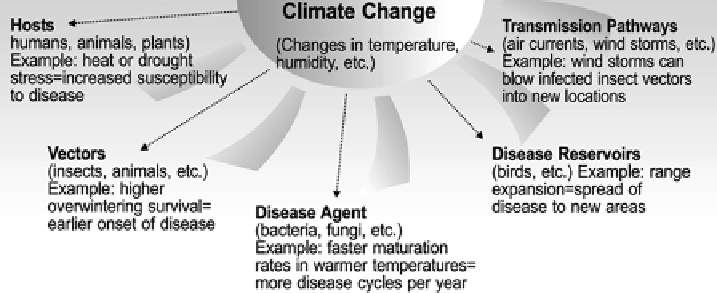Agriculture Reference
In-Depth Information
Fig. 8.1
The effects of climate change on the many components that make up a disease system can be positive or
n e g a t i v e
assessments. The plant pathologists should provide
long-term as well as short-term climate change
adaptation measures to reduce the risk of crop loss
due to sudden emergence of diseases so far unknown
or economically negligible. Therefore, regular dis-
ease monitoring and surveillance is important since
disease management does not work like fi re fi ght-
ing. Disease risk in advance requires for short-term
or tactical disease management, and disease sce-
nario based on climate forecasts are to be the basis
of future strategies. Identifying and quantifying the
impacts of climate changes on plant diseases is a
complex phenomenon (Coakley and Scherm
1996
)
as there is a great deal of uncertainty about the accu-
rate climate forecast.
Crops can be damaged by diseases caused by
fungi (rust, blight, mildew, rot), bacteria/phyto-
plasma (wilt), and viruses. The occurrence of plant
fungal and bacterial pathogens depends on climate
and weather. They are also strongly infl uenced by
agricultural practices. Viruses and phytoplasma are
often transferred via vectors, often insects.
Temperature, rainfall, humidity, radiation, or dew
can affect the growth and spread of fungi and bacte-
ria (Patterson et al.
1999
). Other important factors
infl uencing plant diseases are air pollution, particu-
larly ozone and UV-B radiation (Manning and von
Tiedemann
1995
) as well as nutrient (especially
nitrogen) availability (Thompson et al.
1993
).
Climate factors that infl uence the growth,
spread, and survival of crop diseases include
temperature, precipitation, humidity, dew, radia-
tion, wind speed, circulation patterns, and the
occurrence of extreme events. Typically, the two
most important environmental factors in the
development of plant disease epidemics are tem-
perature and moisture. In temperate regions, most
plant pathogens are not active in late fall, winter,
and early spring because of low temperatures.
Some diseases are favored by cool temperatures,
while others are favored by moderate or hot condi-
tions. Disease often occurs when temperatures are
more stressful for the plant than for the pathogen.
Moisture, in the form of free water or high humid-
ity, is necessary for many pathogens to infect,
reproduce, and spread, although some can cause
disease in dry conditions. Plant diseases require
varying environmental conditions to develop; thus,
it is vital to understand the environmental require-
ments of individual plant pathogens before pre-
dicting responses to climate change (Fig.
8.2
).
Higher temperature and humidity and greater
precipitation result in the spread of plant diseases,
as wet vegetation promotes the germination of
spores and the proliferation of fungi and bacteria
and infl uences the life cycle of soil nematodes. In
regions that suffer aridity, however, disease infes-
tation lessens, although some diseases (such as
the powdery mildews) thrive in hot, dry condi-
tions, as long as there is dew formation at night.
Environmental factors dramatically affect the
development of plant diseases. Plant pathologists
often use a disease triangle to illustrate the intimate
relationship among plants, pathogens, and the envi-
ronment. For a plant disease to develop, a suscep-
tible host, a virulent pathogen, and a suitable

Search WWH ::

Custom Search